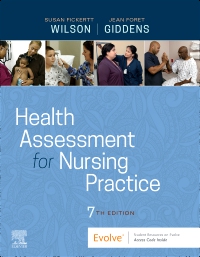
Health Assessment for Nursing Practice Elsevier eBook on VitalSource, 7th Edition
Elsevier eBook on VitalSource

Now $91.79
Make the most of your study time and maximize your health assessment skills! Health Assessment for Nursing Practice, 7th Edition focuses on what you need to know, providing easy-to-understand guidelines for an effective physical examination as well as preparation for the Next Generation NCLEX® Examination (NGN). New to this edition is a greater emphasis on normal findings and less on abnormal findings, new LGBTQ+ Considerations boxes, and new NGN Exam-style case studies. Written by noted nursing educators Susan Fickertt Wilson and Jean Foret Giddens, this book has everything you need to conduct and document an accurate assessment, succeed on the NGN, and prepare for clinical practice.
Binder-Ready Edition: This loose-leaf copy of the full text is a convenient, accessible, and customizable alternative to the bound book. With this binder-ready edition, students can personalize the text to match their unique needs!
Newer Edition Available
Health Assessment for Nursing Practice - Elsevier E-Book on VitalSource
-
- Straightforward, easy-to-understand coverage gives you the essential knowledge and confidence to perform an effective health assessment and physical examination.
- Clear differentiation between basic skills and advanced skills helps you separate basic procedures from those that would be performed by an advanced practitioner or only in special circumstances.
- Proven two-column format links assessment techniques with normal and abnormal findings.
- Full-color photos and illustrations demonstrate how to perform key assessment techniques.
- UNIQUE! Concept Overview boxes present core concepts in the context of health assessment.
- UNIQUE! Clinical Reasoning boxes provide insight by explaining the thought process of an experienced nurse making a clinical decision.
- Patients with Situational Variations sections address special circumstances or needs of patients who are hearing impaired, in wheelchairs, or have other limitations.
- Documenting Expected Findings sections demonstrate how to chart normal findings, including documentation in the electronic health record.
- Case Studies at the end of each chapter give subjective and objective data about a patient and ask you to use clinical judgment skills to answer questions.
- Health Assessment Across the Life Span unit contains four chapters that cover the examination of patients of different ages, including older adults, pregnant patients, infants, children, and adolescents.
- Synthesis and Application of Health Assessment unit provides guidelines for combining the body system assessments into one comprehensive examination, for communicating the findings to other health care professionals, and for adapting the assessment to patients in a hospital setting.
-
- NEW! NGN-style case studies provide optimal preparation for the Next Generation NCLEX® Examination.
- NEW! LGBTQ+ Considerations boxes summarize special assessment considerations for LGBTQ+ clients.
- NEW! Updated coverage of signs of abuse, neglect, and human trafficking equips you to become a mandatory reporter of these growing health problems.
- NEW! Updated, high-quality illustrations accurately represent assessment techniques and the latest examination equipment.
- NEW! Increased emphasis on normal findings is incorporated into the text along with a reduced emphasis on uncommon findings.
- NEW emphasis in the Adapting Health Assessment chapter describes how to adjust your care for patients with a variety of conditions or limitations, such as patients with IVs, casts, and catheters.
- NEW! Updated information on cultural and religious preferences and practices describes how these factors can have an impact on health assessment.
- NEW! UPDATED coverage addresses the latest evidence-based guidelines on pain assessment.
- NEW! Enhanced Review Questions prepare you for the NCLEX exam, with cognitive levels raised from "remembering" and "understanding" levels to "applying" and above to prepare you for clinical practice.
-
Unit I: Foundations for Health Assessment
1. Introduction to Health Assessment
2. Interviewing Patients to Obtain a Health History
3. Techniques and Equipment for Physical Assessment
4. General Inspection and Measurement of Vital Signs
5. Ethnic, Cultural, and Spiritual Considerations
6. Pain Assessment
7. Mental Health and Abusive Behavior Assessment
8. Nutritional Assessment
Unit II: Health Assessment of the Adult
9. Skin, Hair, and Nails
10. Head, Eyes, Ears, Nose, and Throat
11. Lungs and Respiratory System
12. Heart and Peripheral Vascular System
13. Abdomen and Gastrointestinal System
14. Musculoskeletal System
15. Neurologic System
16. Breasts and Axillae
17. Reproductive System and the Perineum
Unit III: Health Assessment Across the Life Span
18. Developmental Assessment Throughout the Life Span
19. Assessment of the Infant, Child, and Adolescent
20. Assessment of the Pregnant Patient
21. Assessment of the Older Adult
Unit IV: Synthesis and Application of Health Assessment
22. Conducting a Head-to-Toe Examination
23. Documenting the Head-to-Toe Health Assessment
24. Adapting Health Assessment
Appendixes
A: Abbreviations
B: Answer Key








 as described in our
as described in our 